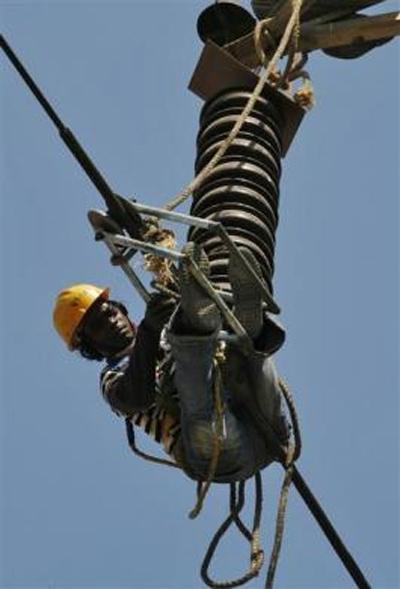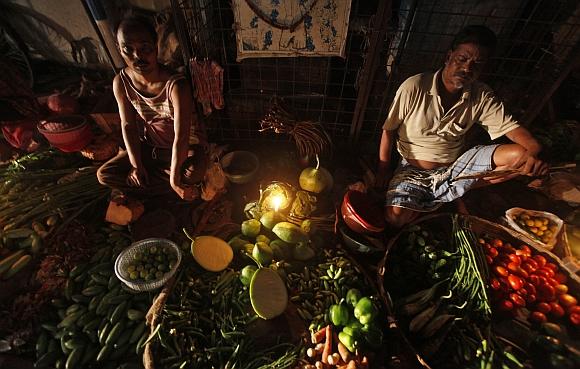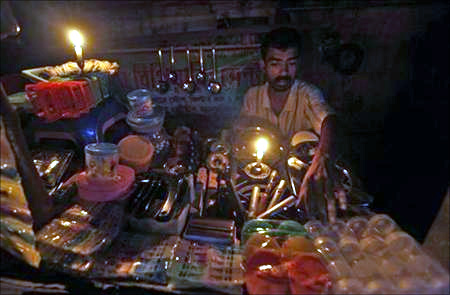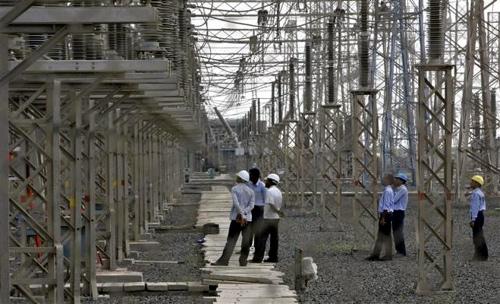Photographs: Amit Dave/Reuters. Megha Manchanda and Manoj Rammohan in New Delhi
Fluctuating between hope of fuel supplies and despair of prolonged grid failures, it was mostly a gloomy year for the power sector in 2012, but it is looking forward to brighter days ahead under a new and young minister.
Persisting fuel scarcity, inter-ministerial turf wars and bleeding distribution companies roiled the sector this year, in addition to the ignominy of witnessing one of the world's worst electricity grid failures that took place in July.
Amid sufferings of common man and businesses alike, the country saw change of guard at the Power Ministry twice. While Sushilkumar Shinde made way for Veerappa Moily as grids snapped across the country, Moily was also soon replaced by young Jyotiraditya Scindia in a major cabinet reshuffle.
Scindia has his plate full of woes, but his initial days hold out promise for the jittery sector.
...
2012: A dark year for India's power sector
Photographs: Reuters.
As another year dawns, Indian power sector would look for better times, just like the projects awaiting adequate fuel supplies.
A few silver linings during 2012 were a proposed Rs 1.9 lakh crore debt restructuring package for ailing discoms and fast-paced efforts to set up islanding system for power transmission in the national capital.
This was despite the year beginning with a promise of reform for power, as Prime Minister Manmohan Singh and top Indian industrialists the likes of Tatas and Ambanis, deliberated on ways to rejuvenate the sector. Notwithstanding a flurry of meetings and committees, coal still remains as scarce as electricity is for unlit villages.
On July 30, Northern transmission grid snapped and paralysed normal life in eight states, including the national capital, for over 15 hours. More shock was in store the next day when over half of the country's population spread across 21 states went without electricity northern, eastern and north-eastern grids failed.
...
2012: A dark year for India's power sector
Image: Traffic moves along a busy road after electricity was restored in New Delhi.Photographs: Adnan Abidi/Reuters.
A high level panel got into the act to identity the cause, which was primarily indiscipline on the part of some states that led to overdrawal of power from the grid.
Incidentally, the second day of grid failure also saw the then Power Minister Shinde moving to the Home Ministry.
The grid failure raised serious questions about Power Ministry's ability to ensure discipline among states, when it comes to drawing of electricity from the grid. Even concerns about overall national security, in the context of electricity grids came to the fore.
The short stint of Moily saw setting up of various committees and a slew of meeting with states as well as private players.
As the country leaves behind the black days of grid collapses, the sector continues to be bogged down by severe shortage of coal. Assurances of redressal are aplenty but fuel is not available to fire many a stranded projects.
...
2012: A dark year for India's power sector
Image: A gas oven mechanic waits for customers in his shop during a power-cut in Kolkata.Photographs: Rupak De Chowdhuri/Reuters.
India, which is aiming to add about 88,000 MW generation capacity in the 12th Five-Year Plan (2012-17), is still caught in the quagmire of differences between the Power and Coal Ministries.
From amendments to existing Fuel Supply Agreements (FSAs) to price pooling of coal, various measures are being discussed but a finality on the direction remains elusive.
Adding to the gloom, fuel availability issues are unlikely to see an immediate solution even though a robust power sector is necessary for 9 per cent economic growth.
Even after Presidential and Prime Ministerial interventions at various junctures, the monopoly of state-run Coal India continues to be an albatross for the power sector.
The scenario is no better for gas-based projects, that are also reeling under acute scarcity. Majority of the power plants in the country are running at low Plant Load Factors (PLF) -- a measure of operational efficiency.
...
2012: A dark year for India's power sector
Image: Engineers inspect electric transmission lines at Adani Power Company thermal power plant at Mundra in Gujarat.Photographs: Amit Dave/Reuters.
Interspersed with these bottlenecks are the never ending haggling over cheap electricity tariffs and pricier imported coal. And the much-awaited revamped bidding documents for upcoming mega power projects is yet to see the light of the day.
All said and done, a final picture is hopefully emerging on the dark horizon of state-run power distribution companies. Gasping for breath, cash-strapped and less efficient discoms are expected to lap up the Power Ministry's proposed debt rejig plan, entailing about Rs 1.9 lakh crore.
Under the scheme approved by the Cabinet Committee on Economic Affairs, 50 per cent of the short-term outstanding liabilities would be taken over by state governments. That is good news but on the flip side, the financial status of many states are strained to say the least.






article